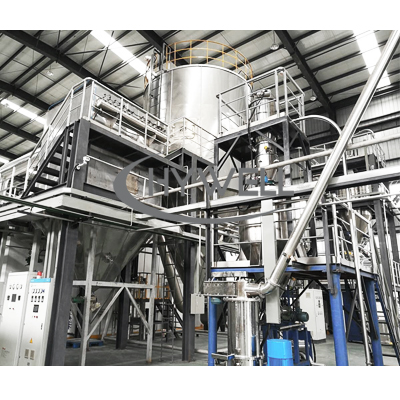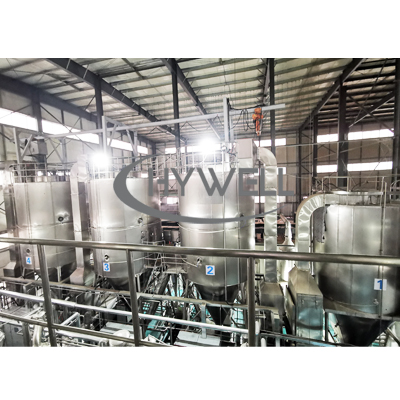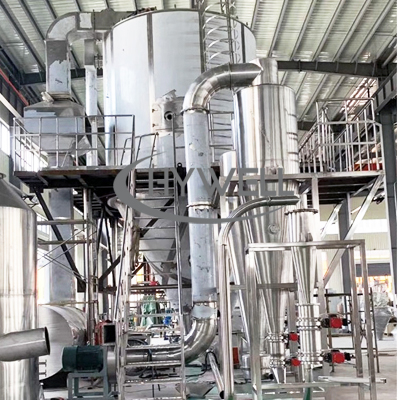Introduction for the Spray Drying
Have you ever wondered how powdered products such as milk, coffee, or protein powder are made? The answer lies in spray drying, a process that converts liquid to powder by removing moisture. Spray drying is a widely used industrial process in various industries, including food, pharmaceuticals, and chemicals. In this article, we will provide you with a comprehensive guide on how to obtain powder from the liquid by a spray dryer.
What is a Spray Dryer?
A spray dryer also named a high-speed centrifugal spray dryer, A spray dryer is a device that uses hot air to evaporate the moisture content in a liquid, leaving behind dry powder particles. The liquid is first atomized into small droplets, which are then dispersed in a hot air stream. As the droplets travel through the air, the moisture evaporates, and the dry particles are collected.

Spray dryer

Spray drying machine

Spray Dryer
How Does Spray Drying Work?
Step 1: Preparation of Liquid
The liquid that is to be dried is first prepared. It can be a solution, suspension, or emulsion. The liquid is usually preheated to a certain temperature, depending on the characteristics of the liquid.
Step 2: Atomization
In this step, the liquid is atomized into small droplets. This can be done using various techniques such as pressure nozzle, and rotary atomizer. The droplet size is crucial as it affects the final product's particle size and morphology.
Step 3: Drying
The atomized droplets are then introduced into a hot air stream. The hot air temperature is usually set to the desired drying temperature, which is specific to the product. As the droplets travel through the hot air, the moisture evaporates, leaving behind dry particles.
Step 4: Collection
The dry particles are then separated from the air stream using a cyclone separator or a bag filter, lab spray dryers almost uses cyclone to collect the powder, but big spray drying machine use cyclone + cloth bag filter to collect the powder. The collected particles are usually further processed, such as sieving or blending, to achieve the desired particle size distribution.
How does the High Speed Centrifugal Spray Dryer Work?
Tips for Optimizing Spray Drying Process
Tip 1: Control the Inlet Air Temperature
The inlet air temperature plays a crucial role in the spray drying process. It determines the rate of moisture evaporation and affects the final product's properties. Setting the inlet air temperature too high can result in particle aggregation or discoloration, while setting it too low can lead to low product yield. The inlet temperature is also tested according to the material characteristics to determine the optimal temperature. In the early stage of new product development, laboratory spray dryers can be used for small batch testing and production to find out the best equipment operating parameters.
Tip 2: Optimize the Atomization Process
The atomization process determines the droplet size, which affects the final product's particle size distribution. It is essential to optimize the atomization process to achieve the desired product quality.
Tip 3: Monitor the Drying Rate
Monitoring the drying rate is crucial to optimize the drying process. It can be done by measuring the moisture content of the inlet and outlet air streams or by using a thermocouple to measure the product temperature.
Tip 4: Choose the Right Nozzle
The choice of nozzle affects the droplet size, spray angle, and spray pattern. It is essential to select the right nozzle based on the characteristics of the liquid and the desired particle size distribution.
What Parts Does the Spray Dryer Contain?
Heating System
The heating system is responsible for heating the air that is used to dry the droplets. The two main components of the heating system are the heater and the temperature controller. The heater is used to heat the air before it is introduced into the drying chamber. The type of heater used depends on the type of fuel that is available. Common types of heaters include electric heaters, gas heaters, and steam heaters.
Atomization System
The atomization system is responsible for breaking the liquid into small droplets, which are then dried using hot air. The two main components of the atomization system are the nozzles and the atomizing air.
Drying Chamber
The drying chamber is where the droplets are dried using hot air. The hot air is introduced into the chamber at the top and flows down towards the bottom. The dried powder is collected at the bottom of the chamber. The three main components of the drying chamber are the cyclone separator, bag filter, and exhaust fan.
Powder Collection System
The cyclone separator is used to separate the powder from the air. The air is passed through the cyclone separator, where the powder is separated from the air and collected at the bottom of the separator.
The bag filter is used to remove any remaining powder from the exhaust air. The exhaust air is passed through a series of bags, which trap any remaining powder particles. The clean air is then released into the atmosphere.
Exhaust Fan
The exhaust fan is used to remove the moist air from the drying chamber. The fan creates a negative pressure inside the chamber, which draws the moist air out of the chamber and through the bag filter.
Control System
The control system is responsible for controlling and monitoring the various components of the spray dryer. The control system includes sensors, controllers, and software that ensure that the spray dryer operates within its specified parameters.
but the temperature controller is used to regulate the temperature of the air that is introduced into the drying chamber. The controller ensures that the air temperature remains constant throughout the drying process, which is crucial for achieving consistent results.
Conclusion
Spray drying is a highly efficient and widely used process for obtaining powder from liquid. The process involves four main steps, namely preparation of the liquid, atomization, drying, and collection. Optimizing the process parameters such as inlet air temperature, atomization process, drying rate, and nozzle choice can help achieve the desired product quality.
FAQs
1. What liquids can be spray-dried?
Spray drying can be used for a wide range of liquids, including solutions, suspensions, and emulsions. Examples include milk, coffee, fruit juices, pharmaceuticals, and chemicals.
2. What is the typical particle size distribution of spray-dried products?
The particle size distribution of spray-dried products depends on various factors such as the droplet size, drying rate, and collection method. Typically, spray-dried products have a narrow particle size distribution with a mean particle size ranging from 10 to 100 microns.
3. What are the advantages of spray drying?
Spray drying offers several advantages such as a high production rate, efficient drying, and control over particle size and morphology. It also enables the production of shelf-stable powders that have a long shelf life and are easy to transport and store.
4. What are the challenges in spray drying?
Spray drying can be challenging due to the complex interplay of various process parameters. It requires careful optimization of the process parameters to achieve the desired product quality. Some common challenges include product stickiness, agglomeration, and particle breakage.
English
Русский
العربية
Français
Español
Português
Deutsch
italiano
日本語
한국어
Nederlands
Tiếng Việt
ไทย
Polski
Türkçe
ພາສາລາວ
Bahasa Melayu
Filipino
Bahasa Indonesia
magyar
Română
Čeština
қазақ
Српски
हिन्दी
فارسی
Slovenčina
Slovenščina
Norsk
Svenska
українська
Ελληνικά
Suomi
Հայերեն
עברית
Dansk
اردو
বাংলা
Hrvatski
Afrikaans
Gaeilge
Eesti keel
Māori
नेपाली
Oʻzbekcha
latviešu
Azərbaycan dili
Беларуская мова
Български
ქართული
Kurdî
Кыргызча

 简体中文
简体中文






